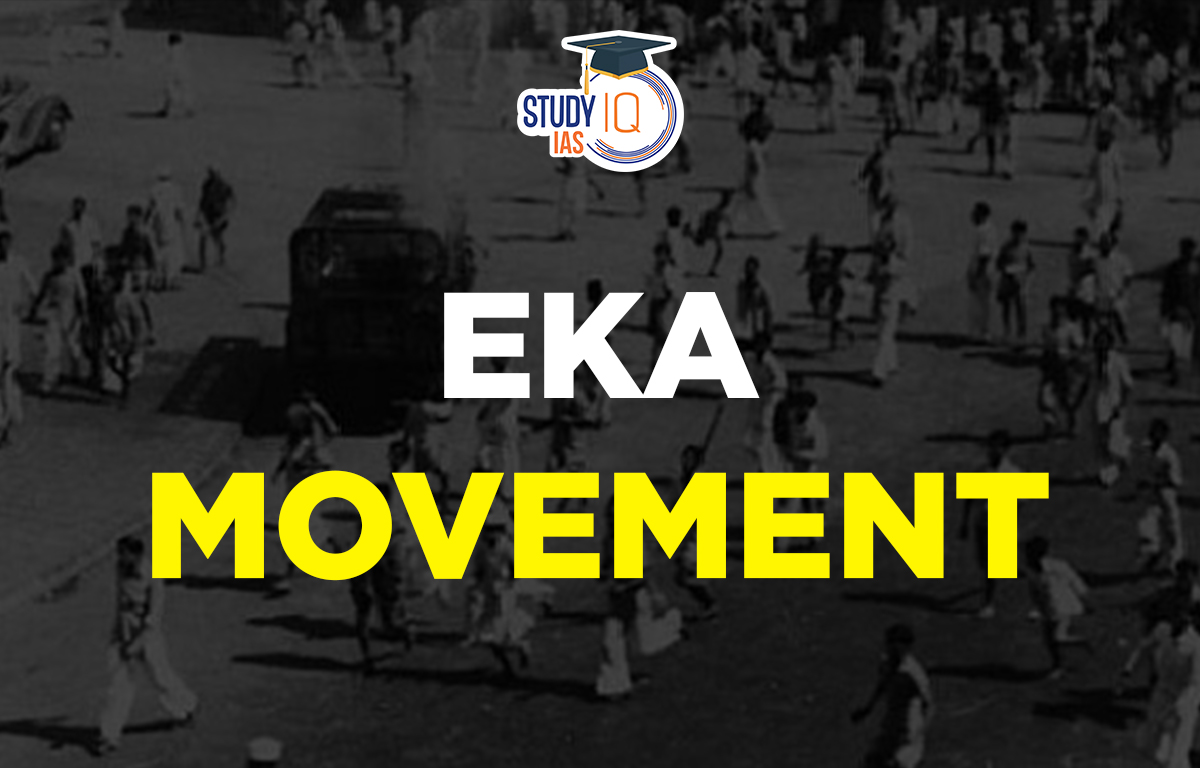Table of Contents
Eka Movement
The Eka Movement is a powerful peasant organisation that started in Lucknow and rapidly spread to the districts of Hardoi, Unnao, and Sitapur. The protests continued from November 1921 until April 1922. Following World War I, a flurry of farmer uprisings broke out in colonial India, including the Eka movement. This article will cover the Eka Movement (1921), which is useful for preparing for the UPSC exam.
Read More: Kisan Sabha Movement
Eka Movement History
A peasant organisation called the Eka Movement, also referred to as the Unity Movement, started in Hardoi, Bahraich, and Sitapur at the end of 1921. Congress and the Khilafat movement founded it, and Madari Pasi subsequently served as its leader. The primary cause of the relocation was the high rent, which in some regions exceeded 50% of the rent as recorded. This movement was helped by the practise of share rent as well as the oppression of the kedars tasked with collecting rent.
The Eka meetings were preceded by a religious ritual in which a hole symbolising the Ganga was dug in the ground and filled with water, a priest was brought in to preside, and the gathered peasants made a vow to pay only recorded rent but pay it on time, would not leave when ejected, would refuse to do forced labour, would not help criminals, would obey Panchayat decisions, would not pay revenue without a receipt, and would remain united under any circumstance.
Small zamindars who were annoyed by the British government’s high demands for land income were a part of this movement. Soon after, Madari Pasi, a leader from a low caste who was unwilling to embrace nonviolence, took over as the movement’s head from Congress. The movement consequently lost touch with the nationalist elite. Mahatma Gandhi was the national leader in this instance, and his philosophy was founded on pacifism. In March 1922, the Eka Movement came to an end as a consequence of harsh government repression.
Read More: Ahmedabad Mill Strike
Eka Movement Causes
The primary cause of the relocation was the high rent, which in some regions exceeded 50% of the rent as recorded. This movement was helped by the practise of share rent as well as the oppression of the kedars in charge of collecting rent. The profoundly exploitative agrarian structure of the Awadh region, which was controlled by Taluqdars (aristocratic hereditary owners of large tracts of land and villages) and zamindars, who were typically ‘upper’ caste Hindus or Muslims, was the root cause of the uprising.
In order to collect land income for the colonial state, they leased land to tenant farmers and charged those exorbitant rents and other fees. Although tenants employed farm labourers to work in the fields, they had no legal claim to the property they farmed and were subject to eviction by the zamindars if they did not pay the rent.
Read More: Surat Split
Eka Movement Objective
- Refusing to pay more than the fee that is listed.
- Requesting rent payment documents.
- They declined to make begar or pay nazrana (forced labour).
Read More: Vernacular Press Act
Eka Movement Outcome
A lack of effective organisation and guidance is to blame for the demise of the Eka movement. However, it succeeded in alerting the administration to the seriousness of the agrarian situation.
The Oudh Rent (Amendment) Act of 1921, which took effect in November 1921 and was designed to quell agrarian unrest and address some immediate peasant complaints, was swiftly approved by the government. A few peasants abandoned the movement as a result of increased government repression, and few were pleased with the advantages offered by the Oudh Rent (Amendment) Act of 1921.
Read More: Ilbert Bill
Eka Movement UPSC
The Eka movement, which started in the autumn of 1921 and peaked in the first quarter of 1922, was then met with a massive police crackdown that included numerous mounted and armed police officers as well as a cavalry squadron. Several of its officials, including Madari Pasi, were compelled to leave due to the state’s severe repression. To prepare for the UPSC Exam, read all the information about the Eka movement.
Read More: Indian National Movement


 Nagari Pracharini Sabha Revival: Backgro...
Nagari Pracharini Sabha Revival: Backgro...
 Ryotwari System in India, Features, Impa...
Ryotwari System in India, Features, Impa...
 Battle of Plassey, History, Causes, Impa...
Battle of Plassey, History, Causes, Impa...





















